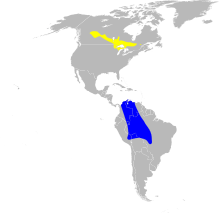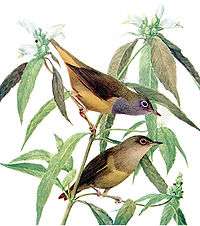Connecticut warbler
| Connecticut warbler | |
|---|---|
| Scientific classification | |
| Kingdom: | Animalia |
| Phylum: | Chordata |
| Class: | Aves |
| Order: | Passeriformes |
| Family: | Parulidae |
| Genus: | Oporornis |
| Species: | O. agilis |
| Binomial name | |
| Oporornis agilis (Wilson, 1812) | |
 | |
| Range of O. agilis Breeding range Winter range | |
The Connecticut warbler (Oporornis agilis) is a small songbird of the New World warbler family.
These medium-sized warblers measure 13–15 cm (5.1–5.9 in) in length, with a 22–23 cm (8.7–9.1 in) wingspan.[2][3] Connecticut warblers weigh 10 g (0.35 oz) when they fledge, attaining an average weight of around 15 g (0.53 oz) as adults. However, birds preparing for migration pack on more weigh to survive the strenuous journey and can weigh up to 25 g (0.88 oz).[4][5] This species has light yellow underparts and olive upperparts; they have a light eye ring, pink legs, a long tail, pale wing bars and a thin pointed bill. Males have a grey hood; female and immatures are more brown and have a whitish throat.
Their breeding habitat is bogs or open deciduous woods near water, especially with poplar or aspen, in central Canada and states bordering the Great Lakes. The nest is an open cup well-concealed in moss or a clump of grass.

These birds migrate to the Amazon River area in South America in winter. Connecticut warblers undertake different migratory routes in spring and in fall, an atypical behavior. In spring, they normally pass through the Midwest and only rarely vagrating to the East Coast, but in fall, larger numbers of migrating birds move through the East Coast.
They forage on the ground, picking among dead leaves, or hop along branches. These birds mainly eat insects and similar small invertebrates but will supplement their diet occasionally with seeds and berries. They are "skulking" birds that usually spend their time foraging within dense, low vegetation. Such behavior often renders them difficult to see well.
The song of this bird is a loud repeated cheepa-cheepa. The call is a nasal pitch.
Despite its name, this bird would probably only visit Connecticut during migration. They are fairly elusive birds, but it appears that their numbers may be declining due to loss of winter habitat.
Taxonomy
Most classification systems consider the genus to be monotypic, with Connecticut warbler as its sole representative, however the South American Classification Committee of the AOU continue to place Kentucky warbler and mourning warbler with this genus.
| Wikimedia Commons has media related to Oporornis agilis. |
References
- ↑ BirdLife International (2012). "Oporornis agilis". IUCN Red List of Threatened Species. Version 2013.2. International Union for Conservation of Nature. Retrieved 26 November 2013.
- ↑ "Connecticut Warbler, Life History, All About Birds – Cornell Lab of Ornithology". Allaboutbirds.org. Retrieved 2013-02-23.
- ↑ "Connecticut warbler videos, photos and facts – Oporornis agilis". ARKive. 2013-02-19. Retrieved 2013-02-23.
- ↑ Lawrence H. Walkinshaw & William A. Dyer (1961). "The Connecticut Warbler in Michigan". The Auk. 78 (3): 379–388. JSTOR 4082276. doi:10.2307/4082276.
- ↑ CRC Handbook of Avian Body Masses, John B. Dunning Jr. (ed.). CRC Press (1992), ISBN 978-0-8493-4258-5.
Further reading
Books
- Pitocchelli, J., J. Bouchie, and D. Jones. 1997. Connecticut Warbler (Oporornis agilis). In The Birds of North America, No. 320 (A. Poole and F. Gill, eds.). The Academy of Natural Sciences, Philadelphia, PA, and The American Ornithologists’ Union, Washington, D.C.
Report
- Cooper JM, Enns KA & Shepard MG. (1997). Status of the Connecticut warbler in British Columbia. Canadian Research Index. p. n/a.
Articles
- Bosque C & Lentino M. (1987). The Passage of North American Migratory Land Birds through Xerophytic Habitats on the Western Coast of Venezuela. Biotropica. vol 19, no 3. pp. 267–273.
- Danz NP, Lind J, Hanowski J, Niemi G & Jones MT. (2003). Forest bird monitoring in northern Minnesota and Wisconsin 1991–2002. Ecological Society of America Annual Meeting Abstracts. vol 88, no 79.
- Elder DH. (1991). Breeding Habitat of the Connecticut Warbler in the Rainy River District. Ontario Birds. vol 9, no 3. pp. 84–86.
- Ferguson RS. (1981). Summer Birds of the Northwest Angle Provincial Forest and Adjacent Southeastern Manitoba Canada. Syllogeus. vol 31, pp. 1–23.
- Hall D. (1995). On rarity and mischance. The Yale Review. vol 83, no 2. p. 74.
- Hobson KA & Schieck J. (1999). Changes in bird communities in boreal mixedwood forest: Harvest and wildfire effects over 30 years. Ecological Applications. vol 9, no 3. pp. 849–863.
- Jahn O, Viteri MEJ & Schuchmann K-L. (1999). Connecticut Warbler, a North American migrant new to Ecuador. Wilson Bulletin. vol 111, no 2. pp. 281–282.
- Machtans CS. (2000). Extra-limital observations of Broad-winged Hawk, Buteo platypterus, Connecticut Warbler, Oporornis agilis, and other bird observations from the Liard Valley, Northwest Territories. Canadian Field Naturalist. vol 114, no 4. pp. 671–679.
- McCaskie G. (1970). Occurrence of the Eastern Species of Oporornis and Wilsonia in California. Condor. vol 72, no 3. pp. 373–374.
- McKenzie PM & Noble RE. (1989). Sight Records for Connecticut Warbler Oporornis-Agilis and Yellow-Throated Vireo Vireo-Flavifrons in Puerto Rico USA. Florida Field Naturalist. vol 17, no 3. pp. 69–72.
- McNair DB, Massiah EB & Frost MD. (1999). New and rare species of Nearctic landbird migrants during autumn for Barbados and the Lesser Antilles. Caribbean Journal of Science. vol 35, no 1-2. pp. 46–53.
- Morgan JG & Eubanks TLJ. (1979). Connecticut Warbler Oporornis-Agilis New-Record in Texas USA. Bulletin of the Texas Ornithological Society. vol 12, no 1. pp. 21–22.
- Niemi GJ & Hanowski JM. (1984). Effects of a Transmission Line on Bird Populations in the Red Lake Peatland Northern Minnesota USA. Auk. vol 101, no 3. pp. 487–498.
- Parker TA, III. (1982). Observations of Some Unusual Rain Forest and Marsh Birds in Southeastern Peru. Wilson Bulletin. vol 94, no 4. pp. 477–493.
- Parmelee DF & Oehlenschlager RJ. (1972). Connecticut Warbler Nest in Hubbard County Minnesota. Loon. vol 44, no 1. pp. 5–6.
- Rogers TH. (1982). The Spring Migration March 1 – May 31, 1982 Northern Rocky Mountain Intermountain Region Canada USA. American Birds. vol 36, no 5. pp. 875–877.
- Schulte LS & Niemi GJ. (1998). Bird communities of early-successional burned and logged forest. Journal of Wildlife Management. vol 62, no 4. pp. 1418–1429.
- Shanahan D. (1992). Notes on calls of breeding Connecticut warblers. Ontario Birds. vol 10, no 3. pp. 115–116.
- Shier GR. (1971). 1st Fall Record of the Connecticut Warbler in Colorado. Colorado Field Ornithologist. vol 10, pp. 19–20.
- Thomas BT. (1993). North American migrant passerines at two non-forested sites in Venezuela. Journal of Field Ornithology. vol 64, no 4. pp. 549–556.
- Venier LA, McKenney DW, Wang Y & McKee J. (1999). Models of large-scale breeding-bird distribution as a function of macro-climate in Ontario, Canada. Journal of Biogeography. vol 26, no 2. pp. 315–328.
- Welsh DA & Venier LA. (1996). Binoculars and satellites: Developing a conservation framework for boreal forest wildlife at varying scales. Forest Ecology & Management. vol 85, no 1-3. pp. 53–65.
External links
- Connecticut Warbler Species Account – Cornell Lab of Ornithology
- Connecticut Warbler – Oporornis agilis – USGS Patuxent Bird Identification InfoCenter
